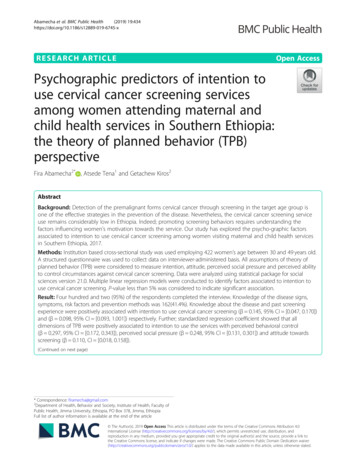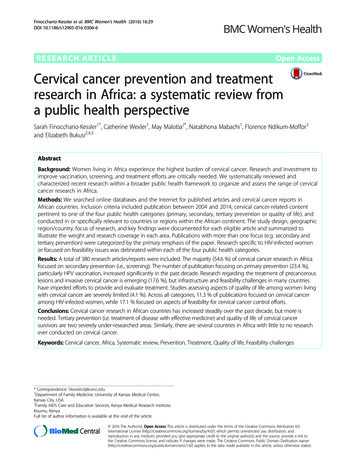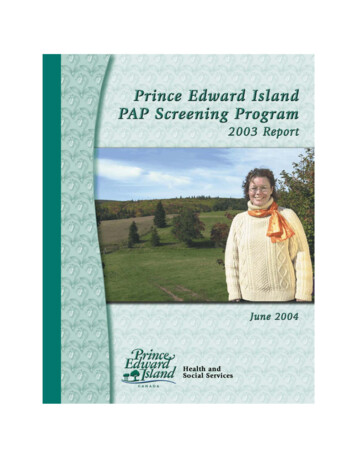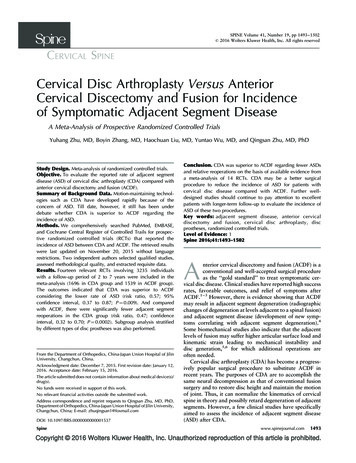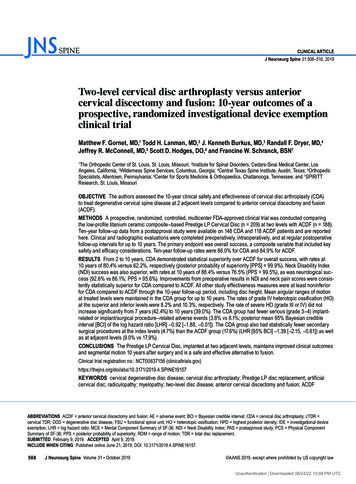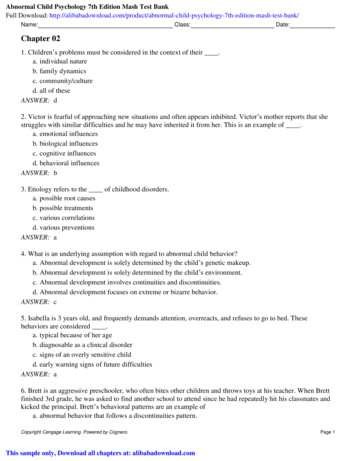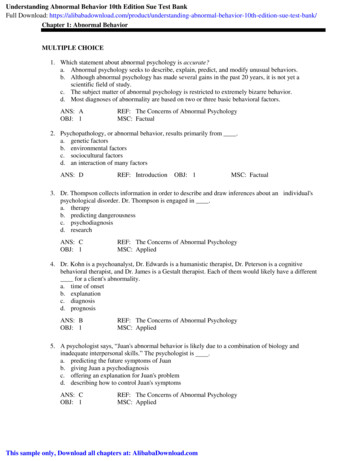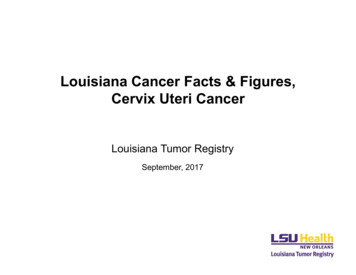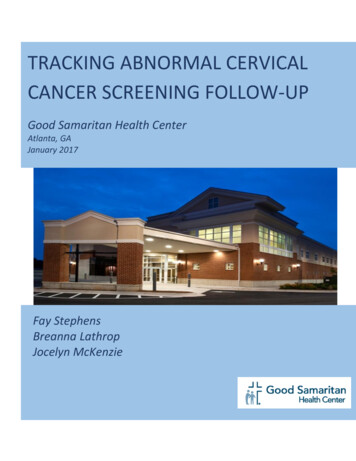
Transcription
TRACKING ABNORMAL CERVICALCANCER SCREENING FOLLOW-UPGood Samaritan Health CenterAtlanta, GAJanuary 201712Emory University, Rollins School of Public Health; Emory University, Laney Graduate School;4Emory University, School of Law; Emory University, School of Medicine3Fay StephensBreanna LathropJocelyn McKenzie12Emory University, Rollins School of Public Health; Emory University, Laney Graduate School;4Emory University, School of Law; Emory University, School of Medicine3
EXECUTIVE SUMMARYBackground:Screening for abnormal cervical cells through the use of Pap tests has contributed to areduction in the death rate due to cervical cancer in recent years as it allows for detection andaction to be taken against early signs of the disease. However, failure to follow-up withdetected abnormalities remains a substantial barrier to further reducing the burden of cervicalcancer in the United States, especially among low-income and minority populations.The Challenge:The Good Samaritan Health Center provides holistic health services to the medicallyunderserved of Atlanta, Georgia. One aspect of the comprehensive care provided by the clinicis cervical cancer screening with Pap tests for all women within the age range at risk of cervicalcancer. The clinic uses an electronic medical record (EMR) system for all of its record keeping,which enables efficient entry and storage of all details regarding patient care and follow-up.However, this system lacks a comprehensive way to track all details regarding follow-up withpatients after receiving an abnormal cervical cancer screening. Using the EMR system alone totrack follow-up with these patients leaves critical gaps in information flow that create thepotential for failure to ensure each patient with an abnormal Pap test receives the appropriatefollow-up care.The Solution:Patient and practice-level barriers to appropriate follow-up exist. The practice-levelbarriers to improved follow-up treatment rates can be addressed by designing a comprehensiveand interactive tracking system for all abnormal pap test results. The Good Samaritan HealthClinic here proposes a solution that operates independently of the EMR in use at a clinic thatcan be adopted by any facility with access to Microsoft Excel software.The Abnormal Pap Tracking System was designed to track all information regardingpatient care following an abnormal Pap test. It includes all relevant follow-up care details, fromthe initial abnormal screening result through the patient’s return to routine screening. Thesystem not only tracks this information but additionally uses a color-coding scheme to visuallyidentify patients in need of immediate follow-up action in the case of a severe abnormality, amissed follow-up appointment, or procedure results remaining unviewed in the EMR. Thesystem records information from every necessary area of follow-up care, including receipt ofinitial abnormal pap test results from the laboratory, notification of the patient, scheduling andcompletion of the initial follow-up visit, and scheduling and completion of all relevantcontinuing care according to clinical guidelines for the patient’s grade of abnormality.
This system can be integrated into clinic workflow with minimal additionaladministrative burden. Once successfully in-place, the Abnormal Pap Tracking System ensuresthat Good Samaritan patients with abnormal cervical cancer screening results receive theappropriate follow-up care, allowing providers to proceed confidently and promoting highquality, evidence based care.
INTRODUCTIONPapanicolaou (Pap) tests possess life-saving power to detect and prevent thedevelopment of cervical cancer in women. However, they are only as effective as the rate offollow-up for abnormal results. According to The American Cancer Society, the death rate ofcervical cancer has dropped by more than 50% over the last 30 years, due largely to theincreased use of Pap tests to screen for early signs of the disease1. However, it is also predictedthat in 2016, there will be almost 13,000 new cases and over 4,000 deaths due to invasivecervical cancer1. Great improvements have been made in detecting and preventing cases ofcervical cancer, but failure to follow-up with all detected abnormalities remains a barrier toreducing the burden of this disease on women in the United States, especially among lowincome and minority populations2. Improving follow-up among women with abnormal Pap testsrequires a coordinated and comprehensive tracking program. Good Samaritan Health Centerdeveloped an abnormal tracking system to promote appropriate follow up among low-incomewomen presenting with cytology and/or HPV abnormalities on Pap tests. The goal of theprogram was to increase the detection and appropriate management of precancerous andcancerous cervical lesions. This paper outlines the development and use of the tracking systemfor abnormal Pap test results and follow-up in place at Good Samaritan.Good Samaritan’s Patient PopulationThe Good Samaritan Health Center provides comprehensive, holistic health care tomedically underserved patients in Atlanta, Georgia. The clinic provides a full range of services,including medical, dental, mental health, nutritional, specialty, and health education services toindividuals and families at or below 200% of the federal poverty level. The majority of theclinic’s population are Hispanic and African American patients, many of whom have little to noaccess to health insurance and very few options for affordable health care. Cervical cancerscreenings are one of the many services the clinic offers women as part of their comprehensivecare.According to the American Cancer society, cervical cancer is most prevalent amongracial minorities in America, who also tend to have the least access to preventative healthcare1. The age adjusted incidence rate of cervical cancer for Hispanic (10.2 per 100,000) andAfrican American (10 per 100,000) women in the United States from 2008-2012 wassignificantly higher than that of non-Hispanic whites (7.1 per 100,000)3. Additionally, the death
rate of cervical cancer among African American women was twice that of non-Hispanic whitewomen from 2008-20123.Despite their higher rates of disease and mortality due to cervical cancer, minoritypopulations face reduced access to preventative health care and treatment, deepening thedisparity in the burden of disease among minority populations in the United States. Accordingto the U.S. Department of Health and Human Services, African Americans and Hispanics wereless likely than whites to have health insurance. Approximately 12% of non-elderly AfricanAmerican populations in the United States and 17% of Hispanic populations were uninsured in2015, compared with 8% of white populations4. This disparity is even larger in the state ofGeorgia, where approximately 16% of African American populations and 30% of Hispanicpopulations lacked health insurance coverage in 20154. In addition to lack of health insuranceas a barrier to care, many patients who speak Spanish at home face an additional languagebarrier when seeking care with providers who do not speak Spanish or provide translationservices for patients5.Lack of health insurance coverage and access to care among minority and low-incomepopulations contribute to an increased risk of inadequate follow-up for an abnormal cervicalcancer screening. Data from a cohort of predominantly urban minority women in Boston, MAwith abnormal cervical cytology from 1999 to 2000 found that the overall rate of inadequatefollow-up for abnormal Pap tests was approximately 38%2. This patient population indicatedsignificant associations between inadequate abnormal Pap follow up and several risk factors,including lack of insurance or having public insurance and younger age 2. The study populationis similar to Good Samaritan’s patient population in several important ways, including theproportion of minority and uninsured or publicly insured patients. Data from a large (N 3,713,531) retrospective cohort study conducted in Ontario, Canada, from 2008-2010 indicatedthat the rate of follow-up after a high-grade lesion on a Pap test was approximately 30% loweramong women in the lowest income quintile compared to those in the highest income quintile6.A significant additional body of literature exists supporting the conclusion that minoritypopulations are at an increased risk for inadequate follow-up for abnormal Pap tests7.Innovative strategies are critical to improve rates of follow-up for abnormal cervical cancerscreenings and reduce the burden of cervical cancer among medically underserved racialminority and low-income populations.Cervical Cancer Screenings and Electronic Medical RecordsIn a health clinic that provides such a wide variety of services as the Good SamaritanHealth Center, a comprehensive system in which all details of patient interactions, fromappointment scheduling through communication and follow-up with results, is critical toproviding quality care. The development of Electronic Medical Record (EMR) systems haschanged the landscape of health care for the better. The benefits of the use of EMR’s areextensive, including increased quality of care, improvements in efficiency, improved financial
and operational performance, and increased capacity for research and improvements inpopulation-level health8. However, these systems are not perfect. Despite the benefits theyprovide, EMR’s can also have unintended negative consequences on health care delivery,including the potential for increased medical errors and disruption of work flow for medicalstaff and providers8.Screening and follow-up for cervical cancer has both benefitted from and been affectedby the unintended consequences of an EMR. The Good Samaritan clinic’s EMR system allowsfor much of the data regarding abnormal Pap follow-up to be completed and recorded in anefficient manner. For example, the receipt, labelling, and matching to patient charts of Pap testresults is much quicker and less labor-intensive with the help of the EMR. However, theautomatization of this record-keeping process leaves room for error in labeling and movementof documents that can cause results to be lost in the system and remain uncommunicated topatients for extended periods of time. In addition, incomplete records of all relevantinformation in a patient’s abnormal screening history (for example, lack of permanent record ofmissed appointments) can cause loss to follow-up of patients, even after they are notified ofabnormal results. The EMR does not prompt providers or staff when an abnormal lab result ormissed appointment slips through the cracks, leaving potentially life-altering informationhanging in the balance without guarantee of discovery.The complexity and automatization of the EMR system increases the efficiency of care atGood Samaritan, but it also provides opportunities for abnormal cervical cancer screeningresults to go unseen by the relevant provider and therefore uncommunicated to the patient. Inthe face of these barriers to complete patient follow-up after an abnormal Pap test, a needexists for a comprehensive system that enables detailed record-keeping of all relevantinformation to patient follow-up after receiving an abnormal Pap test result throughcompletion of care for the abnormality.THE CHALLENGETracking Follow-Up for Abnormal Pap TestsLack of adequate abnormal Pap test follow-up is influenced by multiple factors. Some ofthese factors exist at the patient-level, including various reasons for failure to schedule or makefollow-up appointments such as the prioritization of other life events, and limitedunderstanding of the significance of the abnormality7. There are also practice-level factors thatinfluence abnormal Pap test follow-up rates. Examples of such factors include results lost in theEMR system and failure to follow-up with patients after missed appointments for furthertesting and care7. The practice-level factors can be addressed through the development of asystematic tracking system for abnormal Pap test result follow-up.
The most ideal tracking system for follow-up for abnormal cervical cancer screeningswould be integrated within the EMR system that is already in use at a health center. GoodSamaritan’s EMR system, however, currently lacks the capacity to fully track all relevant detailsand close all potential gaps regarding patient follow-up. One published model for trackingfollow-up operates entirely within the clinic’s EMR through a combination of reports and anembedded Pap test tracking table7. While this system is efficient and desirable in its fullintegration with the EMR system, it is unfortunately not applicable to clinics with EMRs whichdo not use similarly flexible reporting processes or features. With over 400 EMR systemoptions on the market9, designing a solution for tracking abnormal cervical cancer screeningfollow up exclusively within individual clinics’ EMR poses a significant challenge.Despite a multitude of acknowledgements of the increased risk of loss to follow-upamong minority and low-income populations and the publication of individual-level approachesto this problem, the need remains for a system that can be widely used to fill the potential gapsleft by EMR systems in patient follow-up while remaining compatible with clinic work flow andcoordinating smoothly with different EMR systems.Opportunities for Loss to Follow-UpWhen Good Samaritan receives an abnormal Pap test result through the EMR system,there are several opportunities for loss to follow-up without a detailed tracking system forthese abnormal results. After the lab returns Pap test results, the first step in the follow-upprocess is electronic results review by the provider and communication of results to thepatient. This step typically occurs without difficulty, but it is critical to document when andhow the patient was notified of the initial results and that any necessary follow-up care stepswere communicated to the patient. Tracking this initial step allows for the identification of Paptests that were not processed by the lab and promotes accurate documentation of review andnotification.Next, patients with abnormal results need to be scheduled for the appropriate follow upvisit. Multiple opportunities exist for missed follow up visits when relying on the EMR systemalone. Many patients will call and make an appointment for a repeat pap test or a colposcopyas a result of their provider’s explanation of their initial abnormal result. However, relyingsolely on patients to make their own appointments results in a significant proportion of womenfailing to schedule follow-up and receive the necessary care. Additionally, the currentrecommended testing protocol from the American Society for Colposcopy and CervicalPathology (ASCCP) of a one-year follow-up for most low-grade abnormalities with negative HPVresults or HPV positive results without cervical abnormality increases the importance ofensuring patients schedule and attend these critical repeat testing visits after a year passes10. Itis important to track not only the scheduling of a follow-up appointment but also to record thatthis appointment was met by the patient. Without this step in a separate tracking system,
missed appointments disappear from the schedule in the EMR system, creating the potentialfor significant delays in critical follow-up care.Once the patients have successfully scheduled and met their follow-up appointmentafter an abnormal Pap, it is important to make sure that all results of subsequent testings arereceived by the clinic, reviewed by providers, and communicated to the patient. At the GoodSamaritan Health Center, colposcopies are completed by volunteer gynecologists one or twodays each month. Volunteer gynecologists typically have time to perform three to fourcolposcopies per day; hence it is critical in this setting to make sure patients are aware of andattend their appointment, as space is so limited. In addition, because the volunteergynecologists attend the clinic only once per month, there is significant risk of loss to follow-upif the receipt of the results from their ordered labs is not tracked by Good Samaritan staff.Once results have been received and reviewed, it is then critical to record communication withpatients of both follow-up Pap test and colposcopy results. Finally, any subsequent co-testingaccording to American Society for Colposcopy and Cervical Pathology guidelines needs to betracked through the patient’s return to routine screening. For many women, this involves threenormal Pap tests after the initial follow-up testing requiring a detailed record to be kept over anextended period of time to ensure co-testing is met before patients are released to routinescreening10. Finally, it is necessary to keep a record of each patient’s history of abnormalityeven after returning to routine testing for future reference.As detailed above, there are many opportunities for loss to follow up for women whoreceive an abnormal Pap test result, especially in a low-resource setting. A detailed trackingsystem maintained outside of the EMR system allows for records to be kept at each step in theprocess after a woman’s initial abnormal cervical cancer screening. This provides protection ofthe practice through record of patient communication after each screening result, but mostimportantly, it allows for improved patient care by enabling busy providers to quickly trackwhether their patients are receiving the follow-up care critical to their health.THE SOLUTIONTo address this potential for failure in patient follow-up and ensure the best women’s healthcare possible, an abnormal Pap tracking system was designed in Excel that functionsindependently of the medical record system. Given the challenges of Good Samaritan’s specificEMR and the goal of developing a widely-usable format for tracking patient follow-up after anabnormal Pap test, the tracking system was designed in Excel in order to enable providers andsupport staff to quickly identify gaps in patient follow-up. This system tracks all details ofpatient follow-up after the initial abnormal Pap test result through their return to routine
screening, per current guidelines. This system utilizes conditional formatting in Excel to bringattention to the most time-sensitive test results and scheduling needs. It provides a visual aid,separate from the EMR, to ensure that no women are lost to follow-up at any point in theprocess.The Excel Abnormal Pap Tracking SystemThe Abnormal Pap Tracking System, built in Excel, was designed by a Masters of PublicHealth student and is now maintained by the clinic staff. As such, it was designed to be asstreamlined and user-friendly as possible, enabling ease of use and integration into the dailyworkflow of the clinic. It would be most ideal to track all details regarding cervical cancerscreening follow-up in the electronic medical record system. However, the EMR utilized atGood Samaritan does not provide a comprehensive way to store all relevant information towomen’s follow-up care after receiving an initial abnormal Pap test. Excel was chosen as aplatform for this tracking system because of its multiple functions that allow for data storageand manipulation in a user-friendly interface. Relevant patient data was abstracted from theEMR database and stored in the excel document. No patient data is included in the Exceltracking system that is not listed somewhere in the patient’s EMR chart. However, the Excelsheet re-arranges this information into one easy row of data, whereas the correspondinginformation in the patient’s electronic chart is spread out over multiple locations in theirmedical record and appointment history. The Excel tracking system is saved on the clinic’spublic drive which is accessible only by authorized users who are logged into a clinic computer.The system was designed to include all relevant information to each patient’s abnormalcervical cancer screening follow-up treatment and results in one convenient location. As such,several categories of key information are included for every patient, including basicdemographics (name, patient ID, and date of birth) for identification, details regarding thenature of the patient’s initial abnormal cervical cancer screening (the date, cytology result, andHPV result), record of notification of the initial abnormal result, whether a follow-upappointment has been scheduled and met with the appropriate provider, and any subsequentresults and next steps based on follow-up screening results. Information is also included forany referrals for care beyond the scope of Good Samaritan Health Center’s capacity, such asgynecological surgery referrals, as well as details of any patient communication that occursregarding scheduling and follow-up after their initial abnormal screening.This information is organized onto five main spread sheets in the Excel document. Thefirst sheet keeps records of all patients awaiting follow-up from an initial abnormal resultthrough the scheduling, appointment, and result-processing of the initial follow-upappointment or procedure following the abnormal Pap test result. The second sheet in theworkbook keeps record of patients who have received an initial follow-up screening and need
to be followed through three more normal results before release back into routine screening.The third sheet details “closed cases”, where all patients’ records are moved once follow up iscomplete and their case is closed. This sheet is intended to contain both records of patientswho were followed through three follow-up visits, or patients whose case was closed earlierand were only tracked on the initial follow-up page. An example of an early-closing case wouldbe a patient whose initial abnormality was an unsatisfactory result on their initial pap test.Once they return to the clinic and receive a normal pap result, their case is closed out and theyare returned to normal screening, as guidelines do not suggest following these patients yearlyfor three years. This feature allows for flexibility in the way each patient is tracked after theirinitial abnormal result. This is important because of the diverse range of recommended timingfor repeat testing from the American Society for Colposcopy and Cervical Pathology, dependingon the severity of the cervical abnormality and the presence or absence of HPV infection.There is an additional fourth sheet in the workbook that retains all data collected fromthe “initial follow-up” sheet, when these patients are moved from initial to continued followup. The purpose of this sheet is to retain all data collected for the initial follow-up of thepatient, as the continued follow-up sheet contains fewer categories of data for each visit toincrease simplicity of the tracking system. After a patient receives their initial follow-up result,their row is completed in the “Initial Abnormal” sheet, the patient’s name and relevant data isadded to the “Continued Follow-Up” sheet, and all data from the “Initial Abnormal” sheet forthat patient is moved to the fourth sheet, “Moved to Continued Follow Up” for preservation ofthat record.The final sheet in the workbook contains data on patients who are unresponsive tofollow-up efforts by clinic staff. Occasionally, after every effort is made by clinic staff to contactand schedule patients for follow-up, patients fail to schedule or make their follow-upappointments. This sheet provides a detailed record of all attempts to contact patients tonotify them of their abnormal results and the importance of follow-up care. In the rare eventof a lack of response by the patient, it is important to document that every possible effort wasmade by clinic staff to arrange for the recommended follow-up procedures and responsibility isnow in the patient’s hands for their care. This information is also recorded in the patient’selectronic medical record. This sheet includes both patients who are not able to be contactedby phone or mail and patients who repeatedly schedule but fail to attend clinic visits.Color Coding to Facilitate Follow-UpConditional formatting in Excel was used to create a color coding system that alertsusers to patients with the most pressing follow-up needs (Figure 1). The workbook is formattedso that key words typed into specific cells turn that patient’s row a pre-set color to quickly alertusers to their next step in follow-up care (Figure 2). A key is provided on each page of theworksheet to facilitate interpretation of the colors (Figure 3). The color coding scheme was
designed to avoid patient loss to follow up at each step in follow-up care after an abnormal Paptest result, where risk of failure to achieve adequate follow-up exists through use of the EMRsystem alone.Within the color coding scheme, darker colors indicate a more pressing patient followup need. This allows busy staff to quickly identify patients to call first and how to prioritize timespent scheduling follow-up visits. For example, the rows of patients who are scheduled fortheir necessary follow-up appointment are coded green. Patients who need to be scheduledfor a repeat Pap test are coded a light yellow. When guest services or other clinic staffmembers schedule a repeat Pap according to the opening of the clinic’s schedule (in GoodSamaritan’s case, three months in advance), typing “yes” into the column labeled “Follow-UpScheduled?” on the abnormal Pap tracking spreadsheet will cause that patients row to turngreen, indicating they are scheduled for a follow-up visit.In the case of more serious abnormalities for which a colposcopy is required as soon aspossible, the patient’s row turns dark orange when the word “colposcopy” is entered into thecolumn of the spreadsheet titled “Next Step”. This allows clinic staff to easily scan thespreadsheet for more severe abnormalities that need to be scheduled as soon as possible. Inthe case of Good Samaritan, volunteer gynecologists see patients one day per month, soefficient scheduling is critical to ensure appropriate follow-up procedures are scheduled formore severe abnormalities. In addition, all darker colors override lighter colors in the codingscheme. This design feature was added to ensure that even after a patient is scheduled fortheir colposcopy, the row remains orange so that staff can easily remember to ensure thecolposcopy appointment was met, results were received, results were reviewed by theappropriate provider, and the patient was notified of the results and any necessary next steps.If a patient fails to attend an appointment, their row on the spreadsheet turns dark pinkwhen the words “no show” are entered into the column titled “Appointment Met?”. This visualalerts staff to the urgent need to reschedule this patient so that she is not lost to follow-up.Once she is rescheduled, the words “no show” must be removed from the cell in order for herrow to turn green indicating she is scheduled, because all darker colors are coded to overridethe lighter colors above them. Finally, in order to avoid the possibility of lab results lost in thewrong section or provider inbox within the EMR system, patients’ rows turn dark red whentheir follow-up appointments are still in review and have not been processed. When clinic staffupdate the patient’s row after they meet a follow-up appointment, entering the word “review”in the column labeled “Next Step” turns the row red, indicating that patient is awaitingnotification of their results. When providers review the results and notify the patient, theyupdate the next step column accordingly and the red color is removed.Conditional formatting of the Excel spreadsheet allows the abnormal Pap follow-uptracker to visually display all patients with an urgent need for follow-up and those at risk forbeing lost within the EMR system through an unscheduled or missed appointment, lab results
stuck in the review process, or any other error that can disrupt the follow-up process. Thissystem does require a certain amount of time to maintain, but this resource investment isminimal when weighed against the benefits of ensuring that all women with an abnormal Paptest result receive the appropriate care.Maintaining the System to Track Patient Follow-UpWhen providers receive an abnormal Pap test result, their first step is to enter thepatient’s information into the first sheet, Initial Abnormality, of the abnormal Pap trackingspreadsheet in Excel. Providers can enter as much information as their time allows, but themost critical step is simply adding the patient to the list to ensure complete follow-up after anabnormal result. Once basic patient demographics and initial results have been entered, theprovider or quality management staff enters the date the patient will be due for the necessaryfollow-up. In a case of an HPV-positive result without cervical abnormality, for example, therecommended follow up is a repeat Pap with HPV testing in one year. The date can be enteredas one year from the original Pap test, and that patient’s row in Excel will turn a light yellow,reminding staff to schedule that appointment when the schedule opens for that month. Thisallows for reminders to be kept for repeat visits at extended time intervals, which is a criticalcomponent in appropriately following up on lower-grade cervical abnormalities or the presenceof HPV alone. Colposcopies require more immediate follow-up, so “ASAP” is entered into thecell for the date of follow-up alerting schedulers to attend to that patient more immediately.
Case Study A: Avoiding Loss to Follow-Up through Missed Appointments:Clinical Situation: Patient A’s routine Pap test in November 2015 indicated negative PAP cytology withHPV infection. Her provider added her to the Initial Abnormal sheet of the abnormal pap tracker, andclinic staff scheduled her for a repeat
3Emory University, School of Law; 4Emory University, School of Medicine TRACKING ABNORMAL CERVICAL CANCER SCREENING FOLLOW-UP Good Samaritan Health Center Atlanta, GA Fay Stephens Breanna Lathrop Jocelyn McKenzie . Background: Screening for abnormal cervical cells through the use of Pap tests has contributed to a
